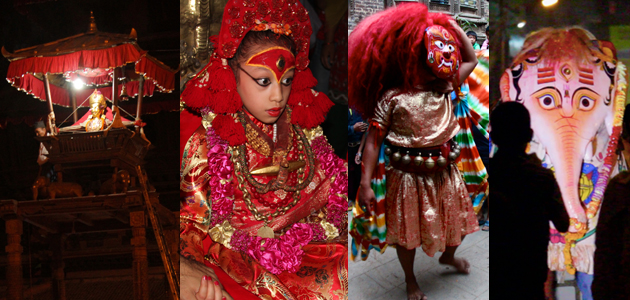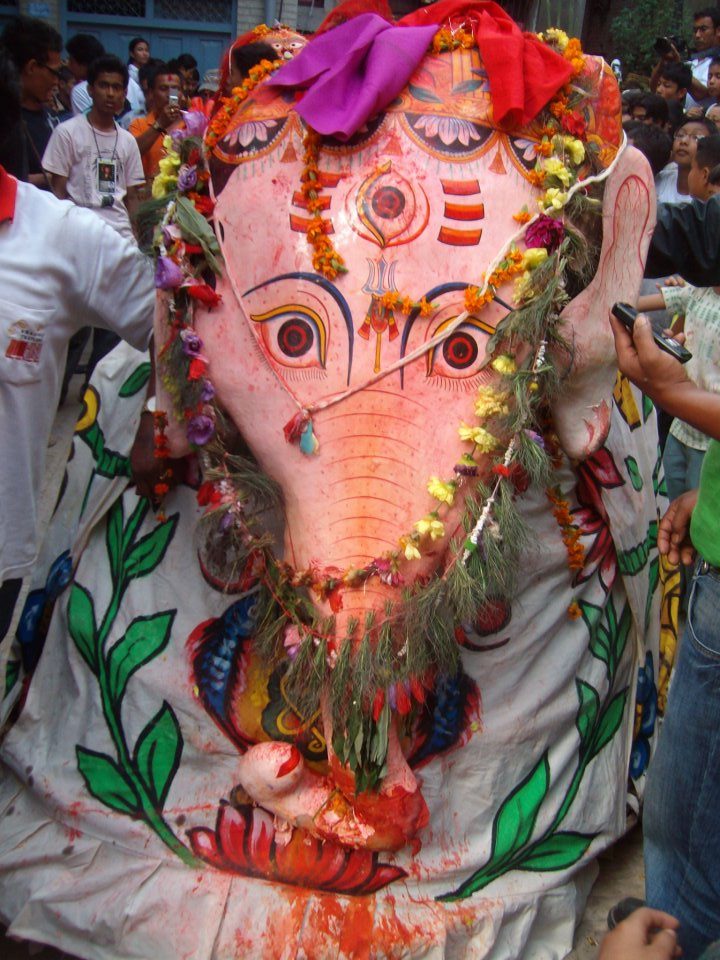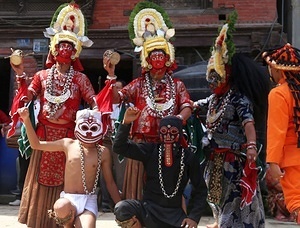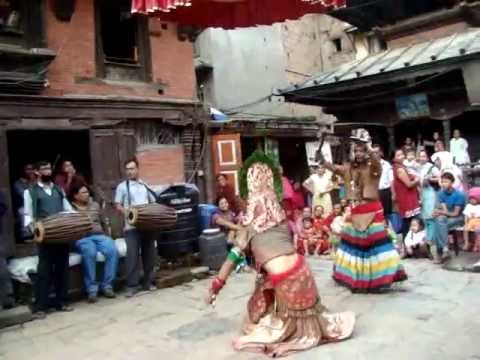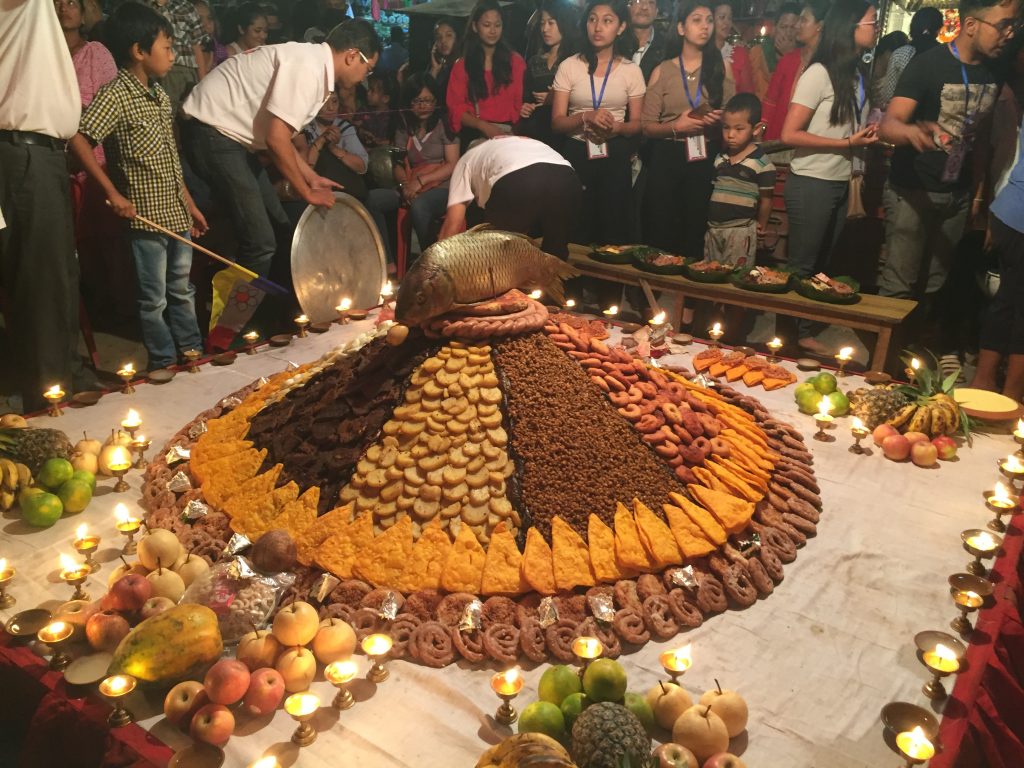Indra Jatra is a festival that is celebrated in honor of Lord Indra, the ruler of heaven, the controller of the clouds and storm. The eight-day long festival is celebrated from Bhadra dwadsahi to Ashwin Krishna chaturdashi according to the lunar calendar, which falls during the months September or October as per Gregorian calendar. This festival is called as YanyaPunhi in local language means the festivals of Kathmandu and the festival is remember for two special occasions: IndraJatra (About Rain God) and the Living Goddess Kumari.
As per the legend, Lord Indra disguised as an ordinary mortal descended in the valley to collect the “parijat” flower. While plucking the flower he was caught and was imprisoned by the locals. During the festival an image of Indra with his outstretched arms are bound alike a thief and kept for display. A white elephant symbolizing Indra’s vehicle is seen wondering in the streets of the square looking for his master. Legend also mentions that, Indra’s mother too came down to earth to investigate her son’s disappearance and learned that he was kept prisoner. Indra’s mother compensates for her sons release and promised to furnish the valley with fog and dew. She further promised to lead the soul of the ones died that year to heaven. The procession of “dagini” represents the above. Likewise, various other mask dancers in the form of Lakhe, Bhairav and other can be seen performing at the different parts of the city. The god of wrath “Bhairav”is also worshipped during the festival. The other major attraction of the festival is the “Kumari Jatra” which is a chariot pulling festival of the only living goddess accompanied by the Bhairav and Ganesh. The festival occurs through various rituals on different days of jatra. Such as:
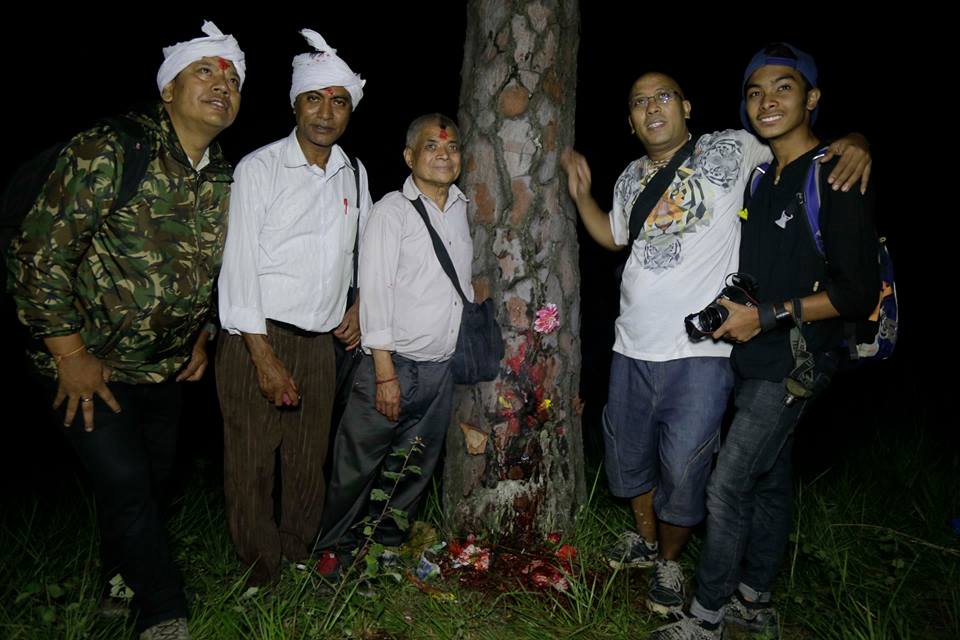
Indra Jatra officially opens on the twelfth day of the waxing moon in September with the raising of the flag of Indra before the old palace at Hanuman Dhoka in Kathmandu. The event is known as Yosin Thanegu in the local dialect which basically means Erection of a Lingam. The tree for the pole is selected by the authorized person from the forest at Sallaghari, four miles east of Bhadgaon. After selecting the appropriate pine tree certain rite are carried out and is dragged to Bhadgaon. After few days, people from Thimi pull the pole to Tudikhel “a parade ground in central Kathmandu”. Four days before the festival begins the people from Kathmandu drag the pole to the durbar square. The pole raising ceremony generally begins at around 7-9 in the morning as per the auspicious time selected by the priests. Hundreds of people gather at the palace square and the surrounding temple to witness the occasion. With the sound of the musical bands the heavy pole is slowly raised with the help of bamboos and ropes. The banner of Indra is unfurled displaying the moon as a symbol of intelligent planning and the sun for courage. The image of Indra is placed in a cage at the foot of the pole along with a golden elephant where visitors offer flowers and other offerings. This is the mark of the beginning of the festival.
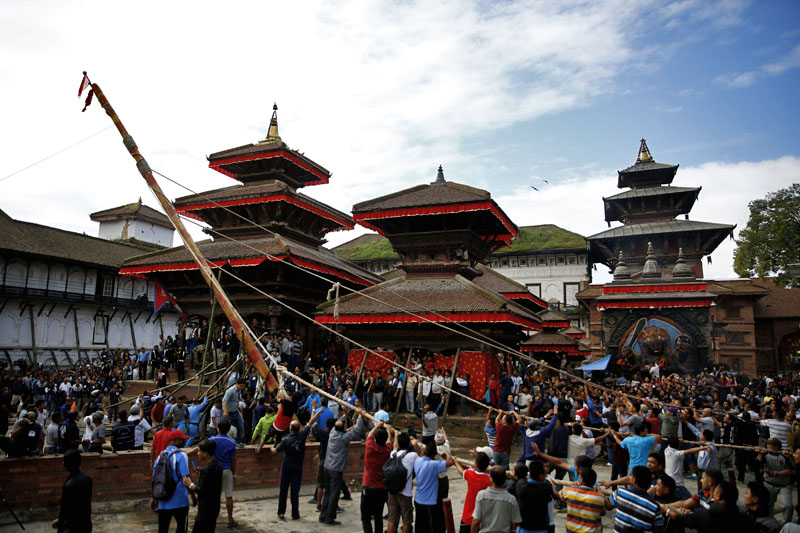
In the evening, hundreds of people head the streets of Kathmandu as a procession in the name of the deceased. They visit various shrines in the old streets with butter lamps to honor their deceased family member. Some offer the lighted wicks in the small clay dish to the shrines and relatives on the way as they pass while some chants religious hymns. It takes nearly about three hours to complete the procession.
Indra Jatra is one of the biggest and historic festivals celebrated in Kathmandu. It is the same festival on the occasion of which King Prithvi Narayan Shah dethroned the Malla kings of the valley and made Kantipur his Capital. There are various mask dances that are performed during the festival. Other than this various masks of Bhairab, the god of wrath made of wood, brass and stones are placed along the streets inside elaborate canopies draped with garlands and finery.
Some of the famous mask dances are:
Lakhey Dance
Majipa Lakhey is a special lakhey considered to be the protector of the children. According to the legend, a lakhey is supposed to have fallen in love with a girl from Majipa. So, the demon takes form of a human and enters the city to see his beloved. Upon knowing the fact that the person is a lakhey, the people captured the lakhey and presented him to the King. The King makes a proposal to the demon that he will grant him a place in the city if he vows to preserve the children from other demons and participate in the annual Yanyaa Punhi Jatra (also called Indra Jatra). The lakhey agrees and is supposed to reside in Majipa ever since.
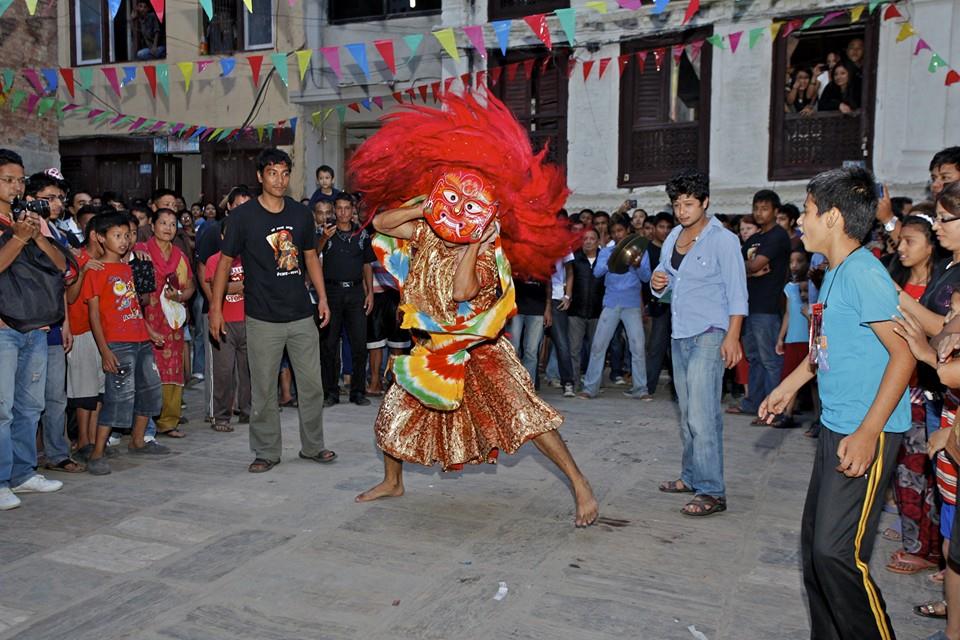 A mask dancer dressed as the demon Lakhey during Indrajatra
A mask dancer dressed as the demon Lakhey during Indrajatra
Sawa Bhakku (Bhairav Dance)
The Sawa Bhhakku is the mask dance that is performed during the festival of Indra Jatra. The dancers consist of Bhairava (in blue) holding a sword and his two attendants (in red). The dance group is from Halchok, at the western edge of the Kathmandu Valley. The dancers make its rounds along the festival route, stopping at major street squares to perform and receive offerings from devotees.
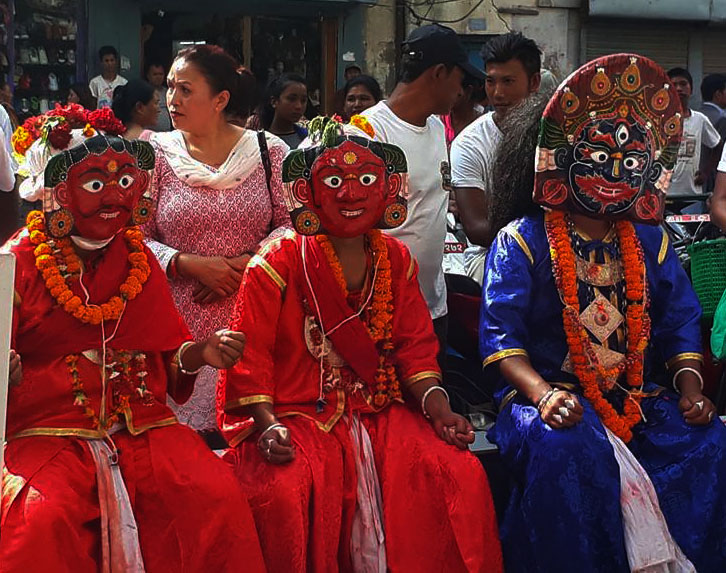 Aakash Bhairav along with Kumari and Chandi from Halchowk during the Indrajatra
Aakash Bhairav along with Kumari and Chandi from Halchowk during the Indrajatra
Pulu Kisi (elephant) dance
This dance is performed by the residents of Kilagal Tole. Pulu Kisi is believed to be the carrier of Indra himself. Pulu Kisi goes through the streets of the ancient city Kathmandu in search for his imprisoned master. People view the masked creature with roar of excitement and laughter. From time to time it does naughty and mischievous things by running through the street knocking anyone that comes in its path and swinging its tail in an amazing manner. Like other dancers he also has team of musical band and a torch carrier in front.
An Elephant dance performed by the Guthi of Kilagal denotes the searching of his lord Indra when captivated by the locals.
Devi Dance
Devi Dance is performed by the people of Kilagal. This is performed at Kilagal and Jaisidewal when the chariot of Kumari is pulled in the respective places. One of the dancers represents Kumari and in front of the chariot of Goddess Kumari, the mask dancer kills the demon. There are a number of dancers wearing masks of various deities.
A special dance act performed by the people of Kilagal
Mahankali Dance
Mahakali dance is performed by the people of Bhaktapur. During the festival period, the dancers from Bhaktapur perform at Durbar Square and Major Street squares around Kathmandu. There are various dances/ acts in their performance.
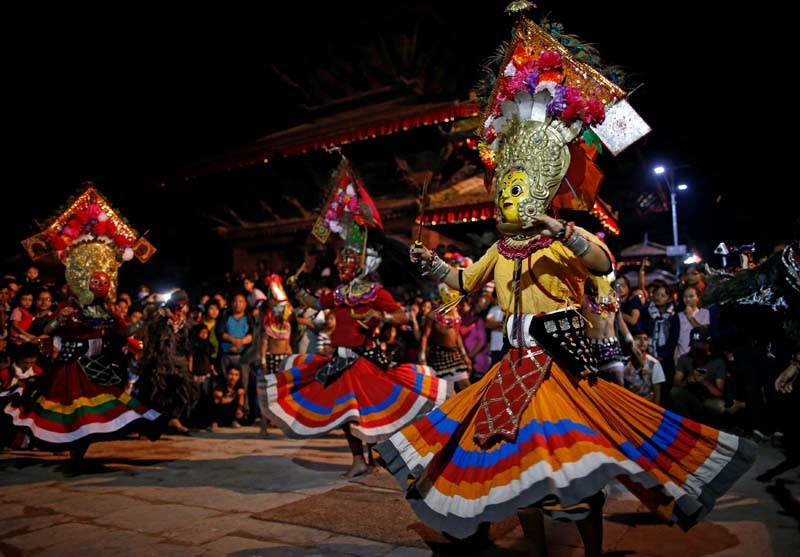 A Traditional mask dance of Bhaktapur performed every night at Hanuman Dhoka during 8 day festival
A Traditional mask dance of Bhaktapur performed every night at Hanuman Dhoka during 8 day festival
Besides the dances the famous masks of Bhairav are displayed are:
Aakash Bhairab:
Chronicles says that the Akash Bhairab is the Kirati king Yalambar who is believed to have gained the powers through tantric worshipping. During the famous battle of the Mahabharat, the first king of Kirat Dynasty went to the battlefield to help the antagonist party. When Lord Krishna heard of it, he promptly chopped Yalambar’s head, which reached Kathmandu through the sky, hence the name given as the Sky God or the Akash Bhairab. The head sits in a Hindu Temple in Indrachok, Kathmandu. It is taken out once a year on the occasion of Indra Jatra Festival. The mask is draped with multiple garlands and finery for the festival.
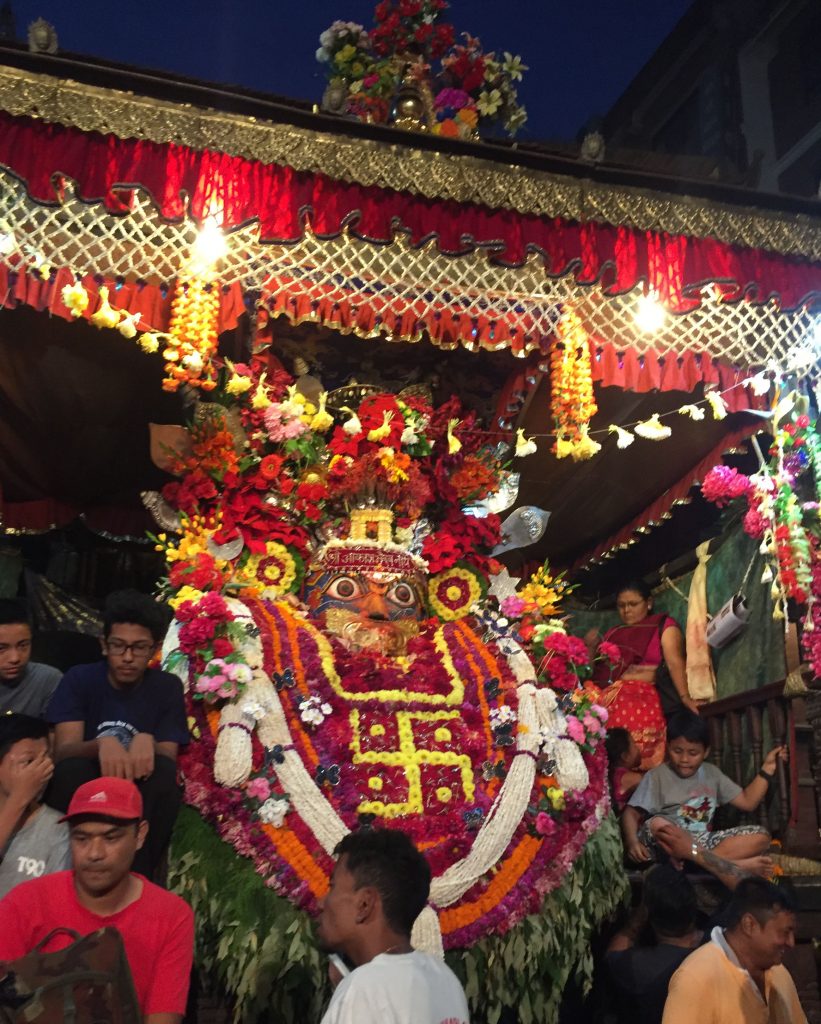 Sacred mask of Aakash Bhairav on display at Indrachowk
Sacred mask of Aakash Bhairav on display at Indrachowk
Swet Bhairab:
The large mask of Swet Bhairava; the wrathful representation of Lord Shiva is revealed to the public only during the Indra Jatra festival. A pipe coming out of the mouth of Bhairava dispenses traditional Nepali liquor (aila) and rice beer (thon) which the youngsters struggle to drink it as a form of blessing from Bhairab.
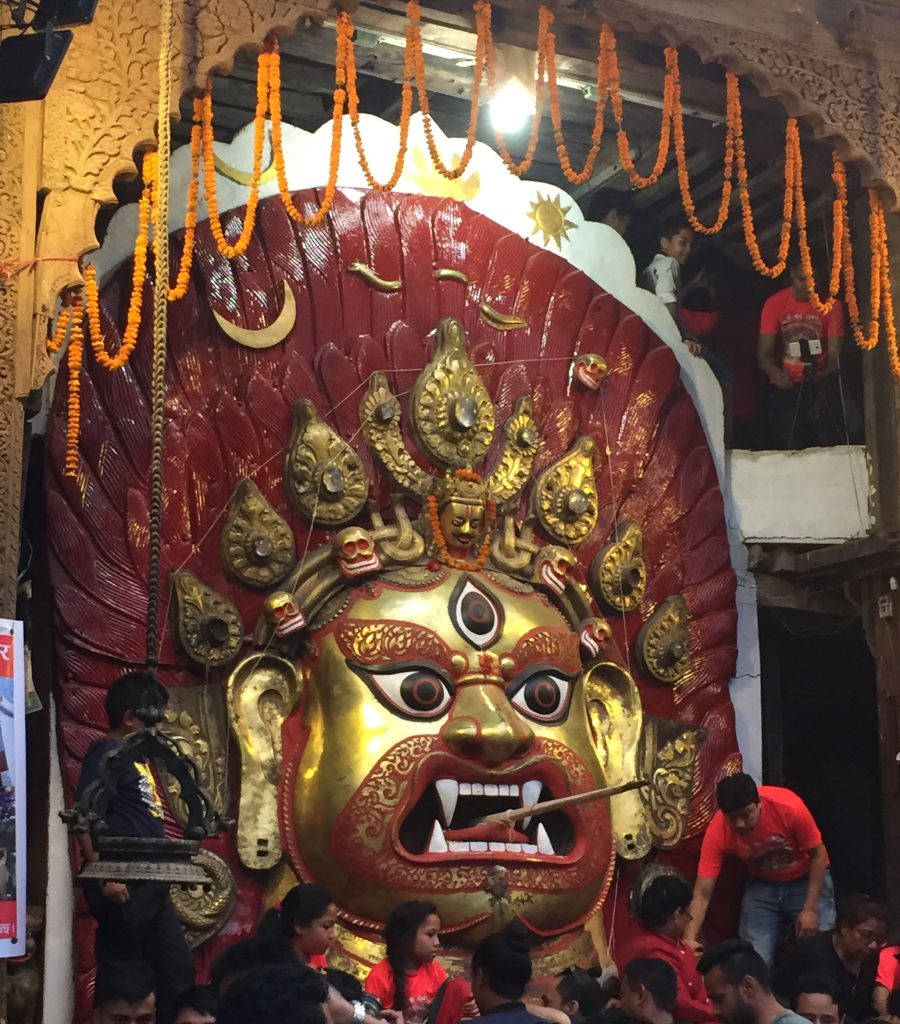 The most wrathful form of Shiva “Bhairav” opened for display at Hanuman Dhoka only during Indra jatra festival
The most wrathful form of Shiva “Bhairav” opened for display at Hanuman Dhoka only during Indra jatra festival
Indra’s Statue:
The idols of Indra with his outstretched arms bound like those of a thief placed on the high scaffolds are also displayed around the town. As per the legend, Indra came to valley disguised as a normal human being in search of Parijat (a kind of flower). Unaware of this fact the people of the valley took him under captive and bound his hands with the ropes. Each night of Indra Jatra, the shrines and masks crowd the palace square.
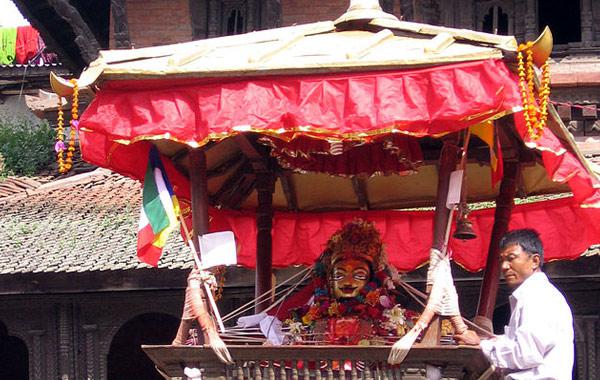 Statue of Lord Indra with both hands Tied displayed infront of Kasthapandap
Statue of Lord Indra with both hands Tied displayed infront of Kasthapandap
Chariot Pulling of Goddess Kumari along with Bhairav and Ganesha (Kwaneya) is the main highlights of the festival. Kumari or Living Goddess of Nepal is the tradition of worshiping young pre-pubescent girls as the manifestations of the divine female deity as per Hindu religion. On this day a chariot festival is held in the palace square which has been in continuation from the period of King Jaya Prakash Malla of Kantipur. On the day of Kumari Jatra, a chariot procession of Goddess Kumari, God Bhairav and God Ganesha in the human form is drawn in the streets of Kathmandu. For her annual chariot pulling procession, thousands of people gather from all over the valley completely filling the square before Kumari House, the stairs of the surrounding temples, the windows, balconies and roof tops of the nearby houses. The head of the state along with the foreign dignitaries line up at the balcony of the old administration building to witness a glimpse of the Gods and Goddess.
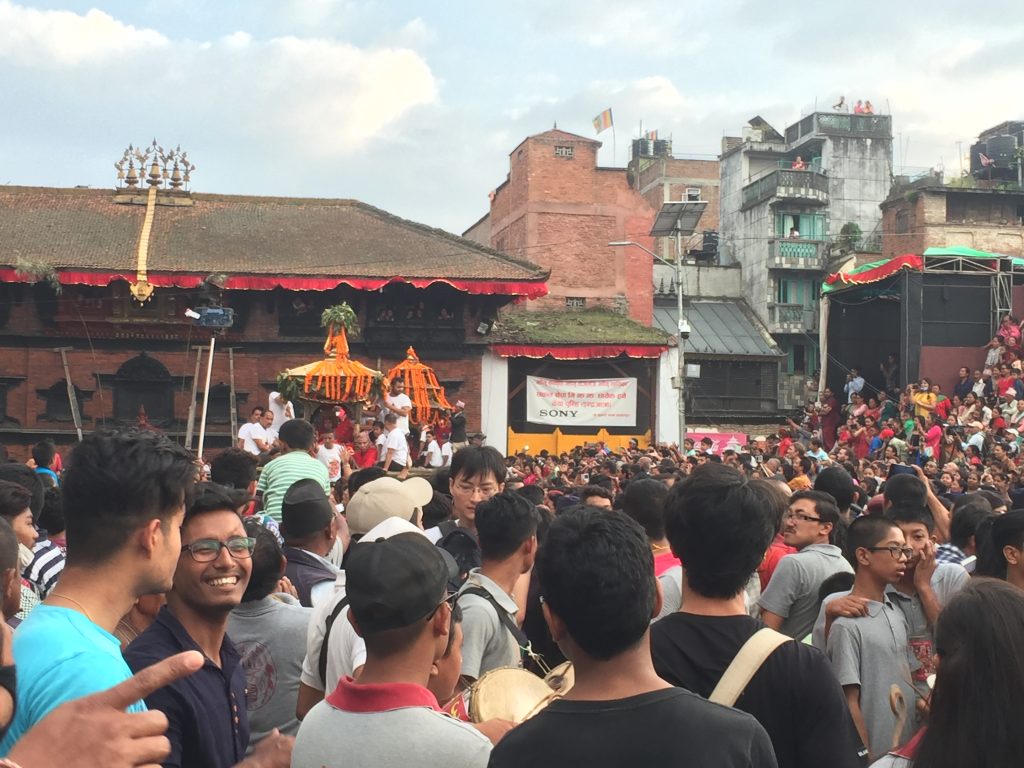 Spectators during the chariot pulling of Lord Ganesh, Lord Bhairav and Living Goddess Kumari
Spectators during the chariot pulling of Lord Ganesh, Lord Bhairav and Living Goddess Kumari
The chariot pulling starts at around three in the afternoon through the southern part of the town known as “Kwaneya” in the local Newari dialect. The route extends from Basantapur, Maru, Chikanmughal, Jaisidewal, Lagan, Hyumata, Bhimsenthan, Maru and back to Basantapur. After the goddess returns back to the Kumari House the chariot pulling ends for a day.
Mata Biye means to offer butter lamps. On the day of Kumari Jatra, the newars specially the followers of Vajrayan Buddhism offers the butter lamps along the processional route and also to the relatives and friends on the way as a mark of respect in honor of the family members deceased in the past year. The procession starts in the evening and follows the following route:
Maru, Pyaphal, Yatkha, Nyata, Tengal, Nhyokha, Nhaikan Tole, Asan, Kel Tole, Indrachowk, Makhan, Hanuman Dhoka, Maru, Chikanmugal, Jaisidewal, Lagan, Hyumata, Bhimsenthan and back to Maru.
In the evening, only after Goddess Kumari reaches her home, a Newari farmer masked and costumed as a female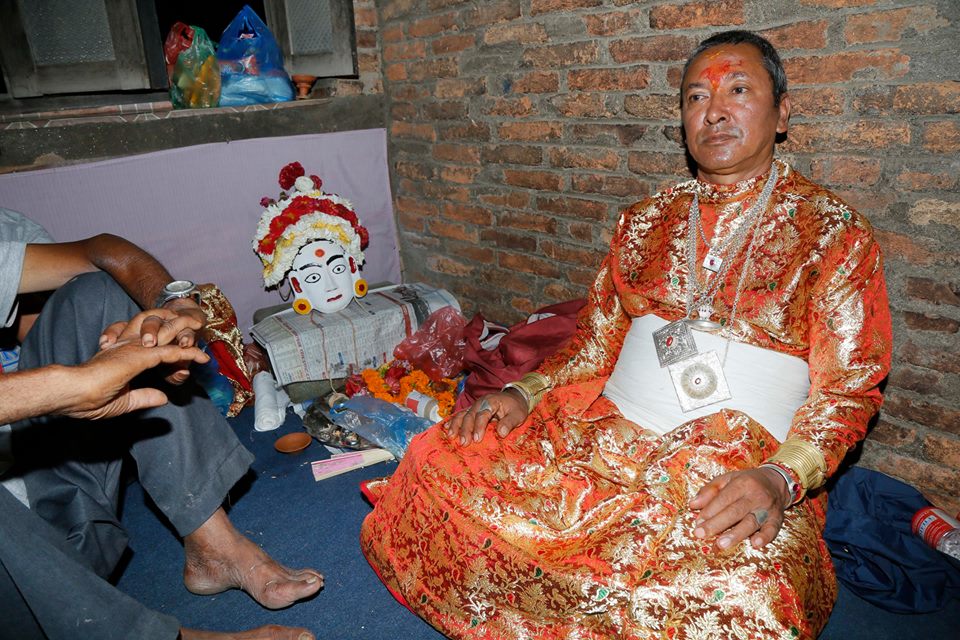 A person waiting for the right time to depict as Dakini “Indra’s Mother
A person waiting for the right time to depict as Dakini “Indra’s Mother
deity namely “Dagin” emerges from the dark streets of Maru supported on each side by the attendants. Dagin is the representation of mother of Indra who has come to earth in search her son. Legend mentions that she has promised to furnish the valley with fog and dew and also to lead the souls of the deceased person to the heaven as a compensation of her son’s release. With respect to this, the family members where death has occurred within the past year form a procession behind Dagin.
 Dakini or Dagin during the circumambulation of the town
Dakini or Dagin during the circumambulation of the town
Bau Mata is the representation of the holy snakes made up of bamboos with a row of oil lamps made by the Newars belonging to the Manandhar caste group. The effigy is suspended from poles and are carried on the shoulders and taken along the festival route. The procession starts when the Dagin returns from the upper part of the town and reaches Maru. It is believed that these two processions should never meet each other.
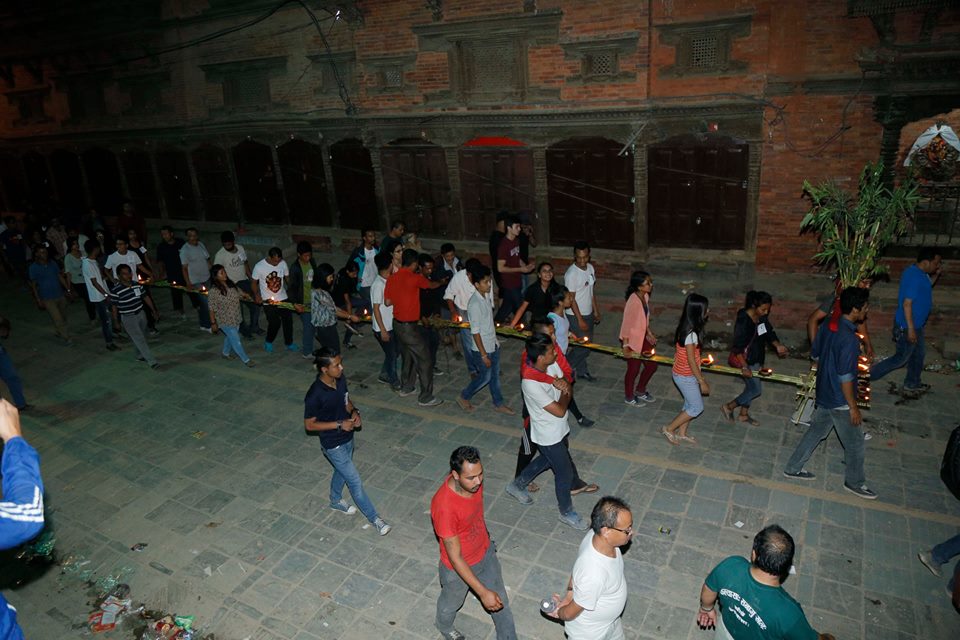 Bahumata- a long train of Bamboo with light wicks following the paths of Dagin
Bahumata- a long train of Bamboo with light wicks following the paths of Dagin
The procession follows the following route:
Maru, Pyaphal, Yatkha, Nyata, Tengal, Nhyokha, Nhaikan Tole, Asan, Kel Tole, Indrachowk, Makhan, Hanuman Dhoka, Maru, Chikanmugal, Jaisidewal, Lagan, Hyumata, Bhimsenthan and back to Maru.
On the second day of the chariot pulling festival. The festival is carried out alike the previous day but the route is different. This day a big pile of Newari Food is prepared and displayed at various places as an offering to the gods and goddess. It is later distributed to the devotees.
A pile of Newari delicacies displayed at Ason
The procession follows the following route:
Basantapur, Pyaphal, Yatkha, Nyata, Tengal, Nhyokha, Nhaikan Tol, Asan Tol, Kel Tole, Indra Chowk, Makhan and Basantapur.
On the last day of the Indra Jatra festival i.e. the eight day the chariot is pulled through the streets of kilagal an old town. Earlier the festival used to be carried out for only 7 days but later it was extended for 8 days by King Jaya Prakash Malla. It is said that one of his concubines living at Kilagal Tole complained that she missed the Kumari procession after which the king ordered that the procession should also be carried out in the streets of Kilagal. Hence, the last day of the festival is named Nanichaya on the name of the half wife of the King. The route where the chariot is pulled is:
Basantapur, Pyaphal, Yatkha, Nyata, Kilagal, Bhedasing, Indra Chowk, Makhan, Basantapur.
The festival is concluded by the lowering of the Linga pole bearing the Indras’ flag after the religious practice. The moment the pole touches the ground, the worshippers rush forward to get the blessings. The pole is then dragged to the Bagmati River near Pachali Bhairav temple where it is cut into small pieces to feed the sacred flame which burns perpetually at Pachali Bhairav Temple.

